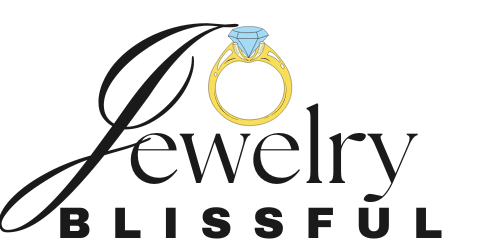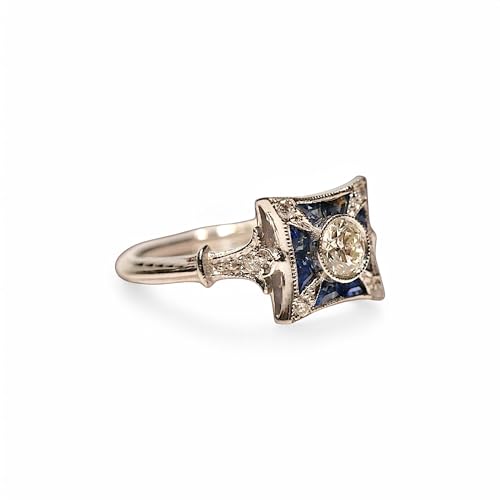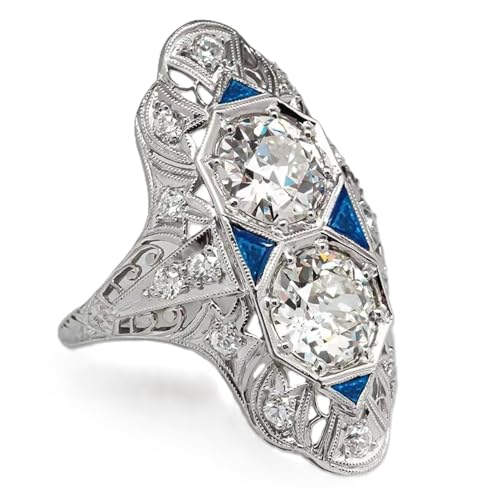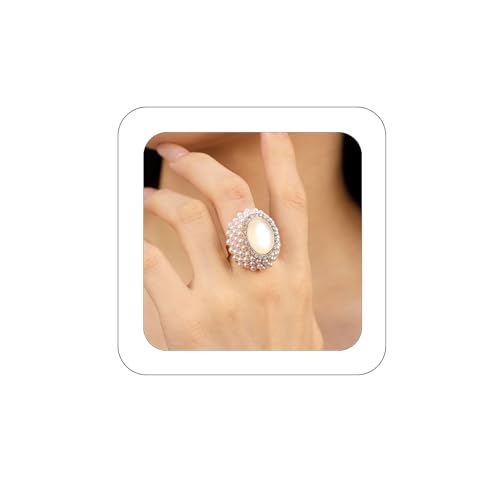Vintage wedding rings 1920s designs capture the timeless elegance and romantic charm of the Art Deco era. The 1920s were a decade of bold style and artistic innovation, and that spirit shines through in the jewelry of the time. Characterized by intricate geometric patterns, filigree details, and the use of dazzling gemstones, these vintage rings continue to inspire modern brides who love classic glamour with a touch of history.
During the Roaring Twenties, platinum and white gold became the metals of choice, giving engagement and wedding rings a sophisticated, polished look. Diamonds were often cut in old European or cushion styles, while sapphires, emeralds, and rubies added vibrant splashes of color. The craftsmanship of the 1920s remains unmatched, making each vintage ring a true piece of art and a symbol of enduring love.
Today, 1920s vintage wedding rings are sought after not only for their beauty but also for their uniqueness and story. Whether you’re drawn to authentic antique pieces or vintage-inspired reproductions, these rings offer a perfect blend of history and elegance. In this guide, we’ll explore the features, styles, and meaning behind 1920s wedding rings — and how to choose one that reflects your personality and timeless taste.
If you’re drawn to jewelry that feels both architectural and romantic, few pieces capture that blend like vintage wedding rings from the 1920s. These rings carry the energy of jazz clubs and skyscrapers, of new materials and old-world craftsmanship. They look crisp. They feel intentional. And they wear beautifully today.
That mix of spirit and structure is why so many couples seek them out now. A ring from this decade has more than sparkle. It tells a story.
What Makes a 1920s Ring Look 1920s
Art Deco defined the decade’s bridal style. Think symmetry, exacting geometry, and a sense of forward motion. Even delicate rings from the period have a clear backbone.
Several hallmarks tend to appear together:
- Clean, squared shoulders and step-like profiles
- Hand-applied milgrain edging that reads like tiny beading along borders
- Filigree and openwork for an airy, lace-like feel
- Angular side stones and calibré-cut gems that frame the center
- Low-to-medium profiles for comfortable daily wear
Designers often paired crisp lines with lyrical engraving. Wheat patterns along the shank. Fan motifs on gallery walls. Chevron shoulders that guide the eye to the center stone. The visual rhythm feels both confident and refined.
Metal Choices of the Jazz Age
Platinum reigned during the decade. Jewelers loved it for its strength, which allowed fine wires and lace-like details without bulk. White gold appears too, especially toward the middle and end of the decade, driven by cost and fashion trends toward cool-toned metals. Yellow gold was used less for engagement rings in that window, though wedding bands in yellow gold do show up.
Choosing among these metals today often comes down to care preferences and how you like the color to age.
Quick comparison of common 1920s metals
| Metal | Color and look | Why it was popular in the 1920s | How it ages today | Care notes |
|---|---|---|---|---|
| Platinum | Cool white with gray undertone | Strength for filigree and very fine prongs | Develops soft patina, resists wear | Occasional polish or leave patina, inspect prongs |
| White gold | Neutral white with a warm base | More affordable alternative to platinum | May show subtle warmth over time | Often rhodium plated, plan for re-plating |
| Yellow gold | Rich, classic gold tone | Less common for Deco engagement settings | Warms and mellows with wear | Polish sparingly to preserve engraving |
Diamonds, Gem Cuts, and Color Accents
The 1920s were a high point for diamond cutting. The brilliant cut we know today was still evolving, and that gives stones from this decade a signature glow. Expect broader flashes of light and more visible patterning compared with modern brilliants.
Common centers and accents:
- Old European cut diamonds with high crowns and open culets
- Transitional round brilliants that bridge the look between old and modern
- Asscher and emerald cuts with step facets and mesmerizing hall-of-mirrors depth
- Baguettes and bullets as geometric side stones
- Single-cut melee for halos and shoulders, which produces a softer twinkle
Color brings Deco rings to life. Calibré-cut sapphires and rubies were set tightly around centers. Onyx, jade, and emeralds were used in graphic patterns. Target rings and halos in two tones, like diamond and onyx, remain unmistakable.
Signature cuts and how to spot them
| Cut style | Shape profile | Sparkle character | Hallmarks to spot | Settings that suit it |
|---|---|---|---|---|
| Old European | Round, high crown, small table | Broad, romantic flashes | Open culet visible from the bottom | Solitaires, halos, engraved shoulders |
| Transitional round | Round, medium crown, modest table | Livelier than OEC, not fully modern | Smaller culet or none, tighter pattern | Solitaires, two-stone shoulders |
| Asscher | Square with cut corners | Step-fire, structured and deep | Concentric squares, clipped corners | Bezel or prong, baguette accents |
| Emerald | Rectangular step cut | Elegant flashes across the steps | Broad facets, long lines | Bezel, tapered baguette shoulders |
| Baguette | Slim rectangular side stone | Subtle flashes, very architectural | Thin profile, straight or tapered | Side accents and geometric frames |
| Single-cut melee | Small round accents | Gentle sparkle, fewer facets | Tiny culet in older stones | Halos, bands, engraving borders |
The mix of cuts and color is where you really see the era’s personality. A platinum halo with calibré sapphires around an old European cut looks crisp yet plush. A square Asscher in a fine milgrain bezel reads like a miniature skylight.
Why These Rings Resonate Today
- They feel personal. The handwork is visible, which gives each piece a signature look.
- They balance sparkle with structure, so the ring reads as design, not just brilliance.
- They support a more sustainable approach to fine jewelry, since they reuse existing metals and stones rather than sourcing new ones.
- They photograph beautifully. Sharp silhouettes and engraved surfaces translate clearly on camera.
And they pair well with modern wardrobes. A Deco ring looks at home with a leather jacket or a silk gown.
Recognizing Authentic Pieces
Original 1920s rings have clues in the metal, the cuts, and the workmanship.
Look for:
- Metal stamps like PLAT, IRID PLAT, 18K, 14K, or 900PT
- Old-style maker’s marks, sometimes tiny and tucked near the base
- Single-cut melee rather than modern full-cut rounds in the halo or band
- Hand-engraved flourishes that are lightly irregular under magnification
- Milgrain that is small and slightly softened with age
- Open culets on old European diamonds and a warmer overall glow
Reproductions often give themselves away with very bright white rhodium finishes, overly perfect repetitive patterns, or modern brilliant-cut accent stones. That does not make them bad, but it helps you separate new from old if you are shopping for period work.
Sourcing With Confidence
Buying antique jewelry rewards patience and good questions. Trusted options include specialized antique dealers, estate sections of legacy jewelers, auction houses, and a few highly regarded online platforms that provide detailed photos and independent grading.
A helpful checklist:
- Ask for a lab report for the center stone when carat weight and value justify it. GIA and AGS reports are commonly used.
- Request measurements, including head dimensions and band thickness, not only carat weight.
- Inspect high-resolution photos from multiple angles, especially the gallery and prongs.
- Confirm whether the ring has been resized, re-tipped, or re-shanked, and where the hallmark sits.
- Check return policies and whether the seller offers a short inspection period.
Provenance can influence price, though many beautiful rings arrive without a documented story. The condition, the center stone quality, the finesse of the metalwork, and the maker (if known) carry more weight.
Budget Planning and Value Drivers
Price varies widely across this category. You can find authentic 1920s wedding bands and modest engagement rings, including vintage wedding rings from the 1920s, under a few thousand dollars, while signed pieces from major houses or larger old European centers command far higher sums.
What tends to move the needle:
- Center stone size, shape, and cut quality
- Rare elements like calibré emerald halos or French-cut sapphires
- Condition of the filigree and original engraving
- Brand signatures and period hallmarks
- Extent of previous restoration
Smart ways to stretch a budget:
- Choose a halo or target ring with a smaller center stone. The look will read larger on the hand.
- Consider lower color grades in old cuts. Many old Europeans in the J to M range face up beautifully in platinum or white gold when paired with blue sapphires.
- Look for single-stone solitaires with strong engraving rather than heavier side-stone layouts.
- Seek transitional rounds or antique step cuts over high-demand OECs in top colors.
Resizing and Restoration
Rings from the 1920s were often die-struck or hand-fabricated. That makes them sturdy where it counts, though delicate areas need care during resizing.
Guidelines that protect the work:
- Use a bench jeweler experienced with antique settings and platinum, not just a general shop.
- Avoid sizing directly through engraved sections when possible. A jeweler can add a small sizing bar inside the shank to preserve detail.
- Re-tip worn prongs with matching metal. Platinum prongs should receive platinum wire.
- Replace missing calibré stones with period-cut replacements, not generic modern cuts.
- Re-create milgrain by hand if it has worn flat, and do this sparingly to retain character.
Keep stamps intact. If a resize threatens a hallmark, ask for a laser-welded insert or a more conservative size shift.
Care and Daily Wear
A well-made Deco ring can be a daily companion. The recipe is routine inspection and gentle cleaning.
Maintenance plan:
- Clean with a soft brush, mild soap, and warm water. Rinse well and pat dry.
- Avoid ultrasonic cleaners for rings with onyx, emeralds, or delicate filigree.
- Schedule professional prong checks once or twice a year.
- Remove the ring for heavy lifting, gym sessions, and tasks like gardening.
- Store in a soft-linen pouch or a separate compartment to protect engraving.
Insurance is wise for any ring you plan to wear often. Ask for a detailed appraisal that cites period, metal, maker marks, stone specs, and replacement method.
Style Pairings and Stacks
Art Deco rings stack like a dream. The architecture invites companions.
Ideas that work:
- A thin diamond band with single-cut stones set in platinum beside a sapphire-accented target ring
- A knife-edge platinum band for a crisp counterpoint to a soft old European center
- A narrow calibré sapphire guard on one side and a plain band on the other
- Mixed metals, like a yellow gold band with a white gold or platinum engagement ring, which highlights engraving and milgrain
For a wedding band, consider a curved or notched guard that hugs the Deco head. Some original 1920s bands were slightly contoured, and modern makers offer custom-fitted options that respect the vintage profile.
Motifs and Cultural Sparks From the Decade
The 1920s drew inspiration from architecture, travel, and art. Skyscraper silhouettes, sunburst patterns, and fan shapes found their way into galleries and shoulders. The 1922 discovery of Tutankhamun’s tomb kicked off an Egyptian Revival, which shows up as lotus forms, stepped pyramids, and stylized scarabs in a few standout rings.
Other currents shaped the look:
- Machine-age technology encouraged precision and repeatable patterns in die-struck components.
- Cubism and early modern art favored clean planes and geometry.
- Shorter hairstyles and new fashion lines made finger rings a focal point, which encouraged bolder shapes at the hand.
You can see these currents in the way light moves across step-cut stones and in the crispness of wheat engraving.
Makers and Marks Worth Knowing
Many wonderful Deco rings are unbranded, made by talented bench jewelers whose names have been lost to time. Signed pieces do exist and tend to command premiums.
Names and hallmarks you may encounter:
- Cartier, Tiffany & Co., Boucheron, Van Cleef & Arpels for high design and impeccable metalwork
- J. E. Caldwell, Raymond Yard, and other American houses with refined Deco lines
- Belais for early white gold alloys and stamps that read BELAIS 18K
- French and British hallmarks indicating assay offices and fineness marks
A maker’s mark is a bonus, not a requirement. Let the ring speak through its craft.
Ring Profiles That Stand Out
A few silhouettes recur across the decade. Learning them makes shopping easier.
- Low-domed solitaires with engraved shoulders and bead-set side accents
- Bezel-set centers with milgrain rims and calibré gemstone frames
- Elongated navette shapes with filigree lattices and a central diamond spine
- Rectangular or square heads with Asscher or emerald centers and stepped shoulders
Each profile brings a different presence. The bezel feels sleek and protective. The navette reads like a vintage lace panel. A stepped shoulder ring has that classic Deco backbone.
Ethical and Environmental Considerations
Vintage wedding rings 1920s reuse what already exists, cutting down on new mining and the environmental impacts that come with it. Many couples value that choice as much as the aesthetics. It is a small, tangible way to tie a personal milestone to a lighter footprint.
Reusing an heirloom is another option. If a ring sits in a family jewelry box, a skilled jeweler can stabilize the setting, re-tip prongs, and adjust the size while keeping the original lines intact. If the setting is beyond saving, the stone can be reset into a period-accurate mount.
Frequently Asked Questions
Can a 1920s ring be a daily-wear engagement ring?
Yes, with mindful care. Platinum helps, as do regular prong checks. If your lifestyle is very active, choose a sturdy bezel or a low-profile halo.
Will a warm tint in an old European diamond be obvious?
In many cases the warmth reads as character. Pairing with blue sapphires or cool-toned metal can balance it, though the tint may be visible in bright daylight. Trust your eye in person or in clear videos.
Is rhodium plating mandatory for white gold?
No. Some people prefer the soft, ever-so-slightly warm tone of unplated white gold. If you prefer a bright white surface, plan on periodic re-plating.
Can a halo be resized later if my finger size changes?
Usually yes, though large size jumps may call for a sizing bar or a partial re-shank to protect the halo’s integrity. Work with a jeweler who specializes in antique pieces.
How do I pair a modern wedding band with a vintage engagement ring?
Match the scale first. A slim Deco ring pairs best with a slim band. Then match the texture. If the ring has engraving and milgrain, echo one of those details on the band or choose a bare, polished counterpoint.
A Short Guide to Trying Rings On
Photographs are helpful, but rings feel different on the hand than they look on a screen.
- Try a range of head sizes to see what flatters your finger length.
- Pay attention to how the gallery sits between your fingers. Comfort is key.
- View the ring in daylight and soft indoor light. Old cuts change character with the environment.
- Check how the ring stacks with a thin band if you plan to wear both daily.
If you shop online, request hand and video shots. A 360-degree view tells you how the facets fire as the ring moves.
Preservation Without Losing Character
One of the joys of a 1920s ring is its soft patina. Tiny nicks, a mellow sheen on the edges, milgrain that is gently softened. Over-polishing can erase that history.
Tips to keep the good stuff:
- Ask your jeweler to polish lightly and preserve engraving.
- Protect the inside of the shank where dates or initials may be inscribed.
- Replace missing accent stones in matched sets, not just by dimension, but by facet style.
Period-correct restoration does not make a ring any less authentic. It keeps the piece ready for the next hundred years.
Where Design Meets Story
Every 1920s ring is a collision of math and emotion. Geometry housing a promise. When you slip one on, you feel the crispness of the era in the angles, and the softness of time in the glow.
That balance never goes out of style.




